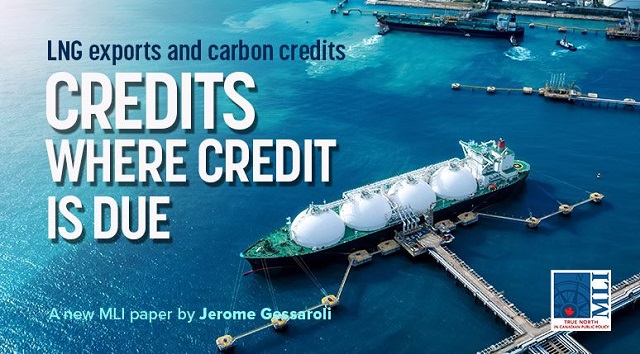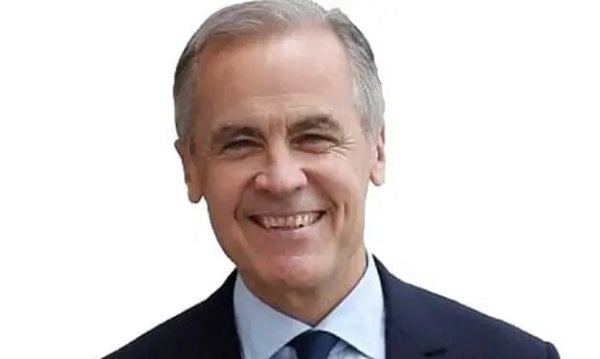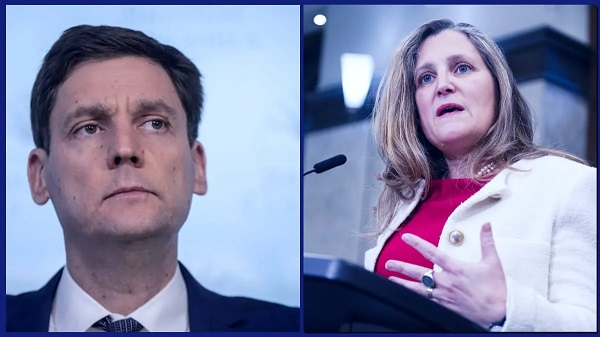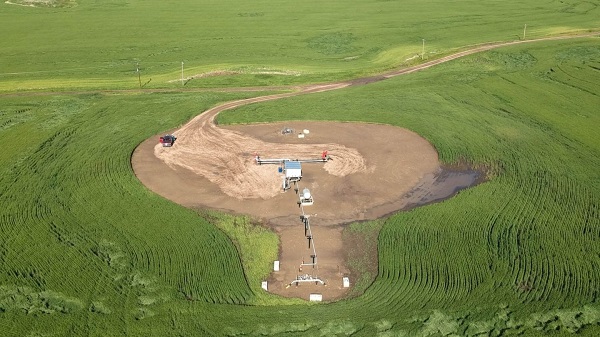Economy
Credits where credit is due: LNG exports and carbon credits

From the MacDonald Laurier Institute
By Jerome Gessaroli
Canada should announce its intent to use Article 6 as a tool to help meet its emissions reduction targets
In this new paper, LNG exports and carbon credits: Credits where credit is due, MLI Senior Fellow Jerome Gessaroli makes the case that Canada can earn ITMOs ( Internationally Transferable Mitigation Outcomes) based on exports of British Columbia-sourced Liquified Natural Gas (LNG). With the potential to significantly lower global carbon emissions and displace coal power in the Asia-Pacific region, such a strategic move by Canada to harness BC’s LNG offers a transformative solution.
Executive Summary
Under the basic current climate accounting rules to which Canada and all other UNFCCC parties have agreed, countries are responsible for reducing GHG emissions within their own national borders. If a country supported a project in another country, it would receive zero credit, no matter what help it may have provided. Therefore, countries have a big incentive to fund projects only within their own borders to help meet their own national carbon reduction goals. That is unfortunate for the planet’s emission reduction efforts. The focus on emission targets within national borders is a shortfall in the nationally based climate accounting system.
To address this shortcoming, the UNFCCC has adopted a framework covered in Article 6 of the Paris Agreement enabling countries to cooperate and share emission reductions. This framework allows carbon credits (known as internationally transferable mitigation outcomes, or ITMOs) to be transferred from the country where the reductions occurred to the country that helped undertake the emissions reduction project.
Sharing emissions reductions through Article 6 is possible when liquefied natural gas (LNG) replaces coal in power generation. This substitution is especially important because coal-fired power plants are expected to produce large amounts of the world’s energy (and GHGs) over the next several decades, even though coal emits much more carbon than other primary fuel sources. Even more troublesome is that new coal plants are still being built in significant numbers. Those new plants alone are expected to emit over 1,415 Mt CO2e (mega tonnes of CO2 equivalent) per year, which dwarfs Canada’s national targeted reductions of approximately 310 Mt CO2e per year by 2030.
Canada, meanwhile, is preparing to become a supplier of LNG. New LNG projects within British Columbia are amongst the least carbon-intensive sources of LNG in the world. BC’s LNG exports could lower global carbon emissions by displacing coal power, particularly in the Asia-Pacific region. Developing markets in Asia would welcome rapidly rising LNG imports. Realistically, BC LNG should be fully used as a substitute fuel to mitigate the carbon emissions impact of existing coal-based power plants, especially those currently used for heating.
While the concept of Article 6, where carbon credits are shared for collaboratively developed projects, is straightforward, the criteria and rules for implementing it are complex. This paper makes the case for how Canada can earn ITMOs based on exports of British Columbia-sourced LNG. An important criterion for making projects ITMO eligible is that the project would not have gone ahead without carbon credits being available. This suggests deals should be structured involving LNG exports along with some other value-added Canadian participation that assists a developing country in switching from coal to LNG as a fuel source. The ITMOs Canada receives could offset any incremental costs we would incur.
If Article 6 is used, the assertion that British Columbia’s pursuit of LNG production would prevent the province from meeting its emission reduction becomes inaccurate. Just over half of LNG Canada’s Phase 1 production capacity in British Columbia would result in approximately 1.2 Mt CO2e emissions annually. Using the same production capacity to replace coal for power generation in Asia has the potential to significantly reduce emissions, ranging from 14.9 to 35.2 Mt CO2e per year. Such outcomes underscore the importance of international collaborative efforts.
Canada should announce its intent to use Article 6 as a tool to help meet its emissions reduction targets. The federal government should then work with industry to identify candidates for bilateral agreements. Common methodologies for measuring, tracking, and verifying carbon mitigation outcomes would all need to be developed as would a registry for tracking and transferring ITMOs. These are complex issues, but we can learn from other countries that have already established processes for managing such projects.
Jerome Gessaroli is a senior fellow with the Macdonald-Laurier Institute and is the project lead for the British Columbia Institute of Technology’s Sound Economic Policy Project. He writes on economic and environmental matters, from a market-based principles perspective.
Business
Canada’s loyalty to globalism is bleeding our economy dry

This article supplied by Troy Media.
Trump’s controversial trade policies are delivering results. Canada keeps playing by global rules and losing
U.S. President Donald Trump’s brash trade agenda, though widely condemned, is delivering short-term economic results for the U.S. It’s also revealing the high cost of Canada’s blind loyalty to globalism.
While our leaders scold Trump and posture on the world stage, our economy is faltering, especially in sectors like food and farming, which have been sacrificed to international agendas that don’t serve Canadian interests.
The uncomfortable truth is that Trump’s unapologetic nationalism is working. Canada needs to take note.
Despite near-universal criticism, the U.S. economy is outperforming expectations. The Federal Reserve Bank of Atlanta projects 3.8 per cent second-quarter GDP growth.
Inflation remains tame, job creation is ahead of forecasts, and the trade deficit is shrinking fast, cut nearly in half. These results suggest that, at least in the short term, Trump’s economic nationalism is doing more than just stirring headlines.
Canada, by contrast, is slipping behind. The economy is contracting, manufacturing is under pressure from shifting U.S. trade priorities, and food
inflation is running higher than general inflation. One of our most essential sectors—agriculture and food production—is being squeezed by rising costs, policy burdens and vanishing market access. The contrast with the U.S. is striking and damning.
Worse, Canada had been pushed to the periphery. The Trump administration had paused trade negotiations with Ottawa over Canada’s proposed digital services tax. Talks have since resumed after Ottawa backed away from implementing it, but the episode underscored how little strategic value
Washington currently places on its relationship with Canada, especially under a Carney-led government more focused on courting Europe than securing stable access to our largest export market. But Europe, with its own protectionist agricultural policies and slower growth, is no substitute for the scale and proximity of the U.S. market. This drift has real consequences, particularly for
Canadian farmers and food producers.
The problem isn’t a trade war; it’s a global realignment. And while Canada clings to old assumptions, Trump is redrawing the map. He’s pulling back from institutions like the World Health Organization, threatening to sever ties with NATO, and defunding UN agencies like the Food and Agriculture Organization (FAO), the global body responsible for coordinating efforts to improve food security and support agricultural development worldwide. The message is blunt: global institutions will no longer enjoy U.S. support without measurable benefit.
To some, this sounds reckless. But it’s forcing accountability. A senior FAO official recently admitted that donors are now asking hard questions: why fund these agencies at all? What do they deliver at home? That scrutiny is spreading. Countries are quietly realigning their own policies in response, reconsidering the cost-benefit of multilateralism. It’s a shift long in the making and long resisted in Canada.
Nowhere is this resistance more damaging than in agriculture. Canada’s food producers have become casualties of global climate symbolism. The carbon tax, pushed in the name of international leadership, penalizes food producers for feeding people. Policies that should support the food and farming sector instead frame it as a problem. This is globalism at work: a one-size-fits-all policy that punishes the local for the sake of the international.
Trump’s rhetoric may be provocative, but his core point stands: national interest matters. Countries have different economic structures, priorities and vulnerabilities.
Pretending that a uniform global policy can serve them all equally is not just naïve, it’s harmful. America First may grate on Canadian ears, but it reflects a reality: effective policy begins at home.
Canada doesn’t need to mimic Trump. But we do need to wake up. The globalist consensus we’ve followed for decades is eroding. Multilateralism is no longer a guarantee of prosperity, especially for sectors like food and farming. We must stop anchoring ourselves to frameworks we can’t influence and start defining what works for Canadians: secure trade access, competitive food production, and policy that recognizes agriculture not as a liability but as a national asset.
If this moment of disruption spurs us to rethink how we balance international cooperation with domestic priorities, we’ll emerge stronger. But if we continue down our current path, governed by symbolism, not strategy, we’ll have no one to blame for our decline but ourselves.
Dr. Sylvain Charlebois is a Canadian professor and researcher in food distribution and policy. He is senior director of the Agri-Food Analytics Lab at Dalhousie University and co-host of The Food Professor Podcast. He is frequently cited in the media for his insights on food prices, agricultural trends, and the global food supply chain
Troy Media empowers Canadian community news outlets by providing independent, insightful analysis and commentary. Our mission is to support local media in helping Canadians stay informed and engaged by delivering reliable content that strengthens community connections and deepens understanding across the country
Business
Carney’s spending makes Trudeau look like a cheapskate

This article supplied by Troy Media.
 By Gwyn Morgan
By Gwyn Morgan
The Carney government’s spending plans will push Canada’s debt higher, balloon the deficit, and drive us straight toward a credit downgrade
Prime Minister Mark Carney was sold to Canadians as the grown-up in the room, the one who’d restore order after Justin Trudeau’s reckless deficits. Instead, he’s spending even more and steering Canada deeper into trouble. His newly unveiled fiscal plan will balloon the deficit, drive up
interest costs and put Canada’s credit rating and economic future in jeopardy.
When Trudeau first ran for office, he promised “modest short-term deficits” of under $10 billion annually and a balanced budget by 2019. Instead, he ran nine consecutive deficits, peaking at $62 billion in 2023–24, and nearly doubled the national debt, from $650 billion to $1.236 trillion. That
reckless spending should have been a warning.
Yet Carney, presented for years as a safe, globally respected economic steward, is proving to be anything but. The recently released Main Estimates (the federal government’s official spending blueprint) project program spending will rise 8.4 per cent in 2025–26 to $488 billion. Add in at least $50 billion to service the national debt, and the federal tab balloons to $538 billion.
Even assuming tax revenues stay flat, we’re looking at a $40-billion deficit. But that’s optimistic. The ongoing tariff war with the United States, now hitting everything from autos to metals to consumer goods, is cutting deep into economic output. That means weaker revenues and a much larger shortfall. Carney’s response? Spend even more.
And the Canadian dollar is already paying the price. Since 2015, the loonie has slipped from 78 cents U.S. to 73. Carney’s spending spree is likely
to drive it even lower, eroding the value of Canadians’ wages, savings and retirement funds. Inflation? Buckle up.
Franco Terrazzano of the Canadian Taxpayers Federation nailed it in a recent Financial Post column: “Mark Carney was right: He’s not like Justin Trudeau, he spends more,” Terrazzano argues. “The government will spend $49 billion on interest this year and the Parliamentary Budget Officer projects interest charges will be blowing a $70-billion hole in the budget by 2029. That means our kids and grandkids will be making payments on Ottawa’s debt for the rest of their lives.”
Meanwhile, Canada’s credit rating is under real threat. An April 29 report by Fitch Ratings warned that “Canada has experienced rapid and steep fiscal deterioration, driven by a sharply weaker economic outlook and increased government spending during the electoral cycle. If the Liberal program is implemented, higher deficits are likely to increase federal, provincial and local debt to above 90 per cent of GDP.”
That’s not just a red flag; it’s a fire alarm. A downgraded credit rating means Ottawa will pay more to borrow, which trickles down to higher interest rates on everything from provincial debt to mortgages and business loans.
But this decline didn’t start with tariffs. The rot runs deeper. One of the clearest signs of a faltering economy is falling business investment per worker. According to the C.D. Howe Institute, investment has been shrinking since 2015. Canadian businesses now invest just 66 cents of new capital for every dollar invested by their OECD counterparts; only 55 cents compared to U.S. firms. That means less productivity, fewer wage gains and stagnating living standards.
Why is investment collapsing? Policy. Regulation. Taxes. Uncertainty.
The C.D. Howe report laid out a straightforward to-do list, one the federal government continues to ignore:
Reform corporate taxes to attract capital investment.
Introduce early-stage investment incentives.
Tear down regulatory barriers delaying resource and infrastructure projects, especially in energy (maybe then Alberta won’t feel like seceding).
Promote IP investment with targeted tax credits.
Bring stability and predictability back to the regulatory process.
Instead, what Canadians get is policy chaos and endless virtue-signalling. That’s no substitute for economic growth. And let’s talk about Carney’s much-touted past. Voters were bombarded with reminders that he led the Bank of Canada during the 2008–09 financial crisis. But it was Jim Flaherty, Stephen Harper’s finance minister, who made the hard fiscal decisions that got the country through it. Carney’s tenure at the Bank of England? A different story. As former U.K. Prime Minister Liz Truss put it: “Mark Carney did a terrible job” at the Bank of England. “He printed money to a huge extent, creating inflation.”
Fast-forward to today, and Canada’s performance is nothing short of dismal. Our GDP per capita sits at just $53,431, compared to America’s $82,769. That’s not just a bragging-rights statistic. It reflects real differences in productivity, competitiveness and national prosperity. Worse, over the past 10 years, Canada’s per capita GDP has grown just 1.1 per cent, second worst in the OECD, ahead of only Luxembourg.
We remain a great country filled with capable people, but our most significant fault may be how easily we fall for image over substance. First with Trudeau’s sunny ways. Now with Carney’s global banker persona. The reality? His plan risks stripping Canadians of their prosperity, downgrading our creditworthiness and deepening long-term decline.
It pains me to say it, but unless something changes fast, Canadians face continued erosion in their standard of living and inflation-driven losses in their savings. The numbers are grim. The direction is wrong. And the consequences are generational.
Trudeau fooled voters with promises of restraint. Carney’s now asking for the same trust, with an even bigger bill attached. Canadians can’t afford to make the same mistake twice.
Gwyn Morgan is a retired business leader who has been a director of five global corporations
-

 Alberta6 hours ago
Alberta6 hours agoAlberta Independence Seekers Take First Step: Citizen Initiative Application Approved, Notice of Initiative Petition Issued
-

 Crime5 hours ago
Crime5 hours agoNational Health Care Fraud Takedown Results in 324 Defendants Charged in Connection with Over $14.6 Billion in Alleged Fraud
-

 Health4 hours ago
Health4 hours agoRFK Jr. Unloads Disturbing Vaccine Secrets on Tucker—And Surprises Everyone on Trump
-

 Bruce Dowbiggin7 hours ago
Bruce Dowbiggin7 hours agoThe Game That Let Canadians Forgive The Liberals — Again
-

 Agriculture2 days ago
Agriculture2 days agoCanada’s supply management system is failing consumers
-

 Alberta1 day ago
Alberta1 day agoCOVID mandates protester in Canada released on bail after over 2 years in jail
-

 Business1 day ago
Business1 day agoCanada’s loyalty to globalism is bleeding our economy dry
-

 armed forces24 hours ago
armed forces24 hours agoCanada’s Military Can’t Be Fixed With Cash Alone







